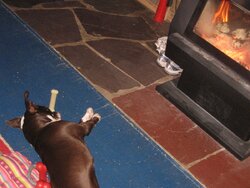My wife and I bought an old one room schoolhouse last Feb., and moved in in April. Long story short, we've done a ton of remodeling and renovating and have moved upstairs into three bedrooms and a bathroom that used to be nothing but an uninsulated, 1000 sq foot, windowless attic. And we made it upstairs before winter . . . hurray!
The big, glaring, unfinished item is the floors. At the moment, the first and second floors are raw OSB and look like crud. I'd love to get something else down, but we don't want to use carpet and aren't in a position to buy the wide board pine that will eventually be going in just yet.
Does anyone have any creative flooring suggestions that I could use to cover the OSB for a year or so? I've thought about canvas stretched tight, and we already have a bunch of rugs down, but the unfinished nature of it is killing me!
The big, glaring, unfinished item is the floors. At the moment, the first and second floors are raw OSB and look like crud. I'd love to get something else down, but we don't want to use carpet and aren't in a position to buy the wide board pine that will eventually be going in just yet.
Does anyone have any creative flooring suggestions that I could use to cover the OSB for a year or so? I've thought about canvas stretched tight, and we already have a bunch of rugs down, but the unfinished nature of it is killing me!


